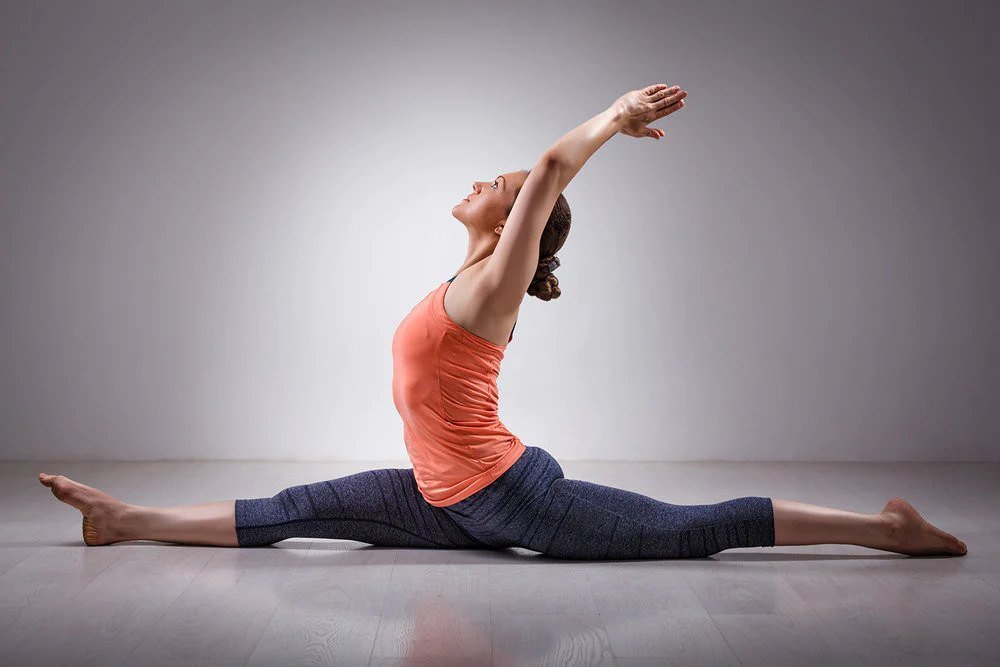Listen to this article:
Key Takeaway
Hatha yoga, the foundation of most styles, offers accessible postures to gently stretch, strengthen, and cultivate mindful self-connection. Breathe, explore the 15 core asanas, and build your own practice, step by step.
From downward dogs to sun salutations to balancing asanas, you have probably done hatha yoga poses without even knowing it. Hatha yoga is one of the most popular yoga practices in the world, and it happens to be the most beginner-friendly.
You can find hatha yoga asanas in nearly every yoga class in the United States. In fact, hatha yoga is so ubiquitous that it’s often just called yoga. It is a broad umbrella term that also houses Ashtanga yoga, Vinyasa yoga, Bikram yoga, and 6 other styles of yoga. Many yoga teachers integrate these postures into vinyasa yoga flows and chakra balancing sequences.
Here’s the top 15 most common hatha yoga poses and how to build your own hatha yoga sequence with them.
Contents
- 1 What is Hatha Yoga?
- 2 History of Hatha Yoga
- 3 Benefits of Hatha Yoga
- 4 Hatha Yoga Sequence of 15 Basic Poses and Asanas
- 4.1 1- Mountain Pose (Tadasana)
- 4.2 2- Standing Forward Fold (Uttanasana)
- 4.3 3- Downward Facing Dog Pose (Adho Mukha Svanasana)
- 4.4 4- Warrior 2 Pose (Virabhadrasana II)
- 4.5 5- Triangle Pose (Trikonasana)
- 4.6 6- Tree Pose (Vrikshasana)
- 4.7 7- Bow Pose (Dhanurasana)
- 4.8 8- Locust Pose (Shalabasana)
- 4.9 9- Cobra Pose (Bhujangasana)
- 4.10 10- Bridge Pose (Setu Bandhasana)
- 4.11 11- Fish Pose (Matsyasana)
- 4.12 12- Hero Pose (Veerasana)
- 4.13 13- Pigeon Pose (Kapotasana)
- 4.14 14- Spinal Twist Pose (Matsyendrasana)
- 4.15 15- Back Stretching Pose / Seated Forward Fold (Paschimottanasana)
- 5 Transitioning from Standing to Seated Positions
- 6 Incorporating Hatha Yoga into Your Daily Routine
- 7 Hatha Yoga FAQs
What is Hatha Yoga?
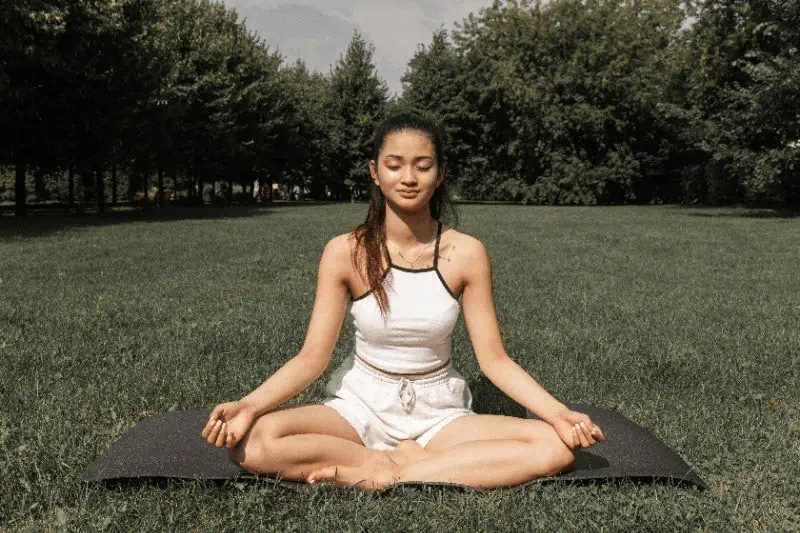
Hatha yoga is technically synonymous with what we call yoga in the west. It is the practice of physical asanas (poses) that aim to stretch, strengthen, and relax the entire body.
In the ancient Indian language of Sanskrit, the word hatha means “effort”, “persistence”, or “force”. It implies pushing your physical and mental capabilities into dynamic movements that benefit your overall health.
Hatha yoga challenges the entire body while using breathing techniques like pranayama to help prepare yogis for meditation. This integration of mind, body, and spirit helps bring you into a higher level of consciousness and physical fitness.
History of Hatha Yoga
The origins of hatha yoga date all the way back to 15th century India. The most well-known hatha yoga text is called the Hatha Yoga Pradipika by Svātmārāma. It outlines 15 main poses- both seated and standing- that were initially designed to help ancient practitioners prepare for long periods of seated meditation.
However, this form of yoga practice is far more than just physical asanas. Traditional yogic philosophy includes a healthful diet, purification practices, regulation of breath (pranayama), meditation, mantras, mudras, and moral codes yamas) to create an integrated system of holistic living.
Hatha yoga builds on ancient yogic philosophies first written by Patanjali in the Yoga Sutras, which outlines the eight limbs of yoga. While physical movement and exercise is the most widely recognized form of yoga in the west, yoga poses (asanas) are only one limb of the whole system.
Benefits of Hatha Yoga
Practicing hatha yoga has transformed millions of lives by integrating exercise with deep breathing and mindfulness. The health benefits of this ancient practice have been proven by modern science as well as ancient techniques.
The aim of hatha yoga is to awaken dormant energy or shakti in the body. Shakti energy is primordial cosmic power embodied in the 7 chakras (or “wheels”) of energy that rise from the root to the crown of the human body. To learn more about the links between yoga and chakras, check out our The Beginner’s Guide to Chakra Healing, Alignment, and Balance.
A weekly hatha yoga class can help to:
- Improve flexibility
- Strengthen muscles
- Improve mood and relaxation
- Improve focus and concentration
- Reduce stress and anxiety
- Aid in weight loss
- Connect to your inner self or a higher power
Depending on the frequency and intensity of your practice, hatha yoga can torch some major calories and drastically improve your mental health. It can even aid in regulating your nervous system, improving digestion, and diving into a deeper meditation state.
Here are the 15 most important hatha yoga asanas for regular practice:
Hatha Yoga Sequence of 15 Basic Poses and Asanas
Per the Hatha Yoga Pradipika, classical hatha yoga sequence includes 15 primary poses. In most hatha yoga classes, you will begin with standing poses and then move to the floor.
You may recognize these asanas from common sequences such as sun salutations or vinyasa flows. Both hatha and vinyasa yoga utilize all of these asanas (and many more), however hatha often focuses on holding poses for longer while vinyasa aims for a flowing movement.
Practice these hatha yoga postures at a slow pace and hold them for several breaths for the maximum benefits.
1- Mountain Pose (Tadasana)

Begin standing with your feet hip width apart, heels and toes grounded into the mat. Check that your spine is straight and hips square to the front.
Roll your shoulder blades down your back, open the chest, and hold your palms open with your arms alongside your body. Inhale and exhale slowly to sync your breath before beginning your practice.
Benefits: This simple standing pose can help improve posture and blood flow near the heart. It helps start your hatha yoga practice with grounded focus.
Chakra Association: Heart chakra (Anahata), linked to the air element
Variations: You can also raise your arms overhead with the hands facing each other and shoulders relaxed down away from the ears.
2- Standing Forward Fold (Uttanasana)
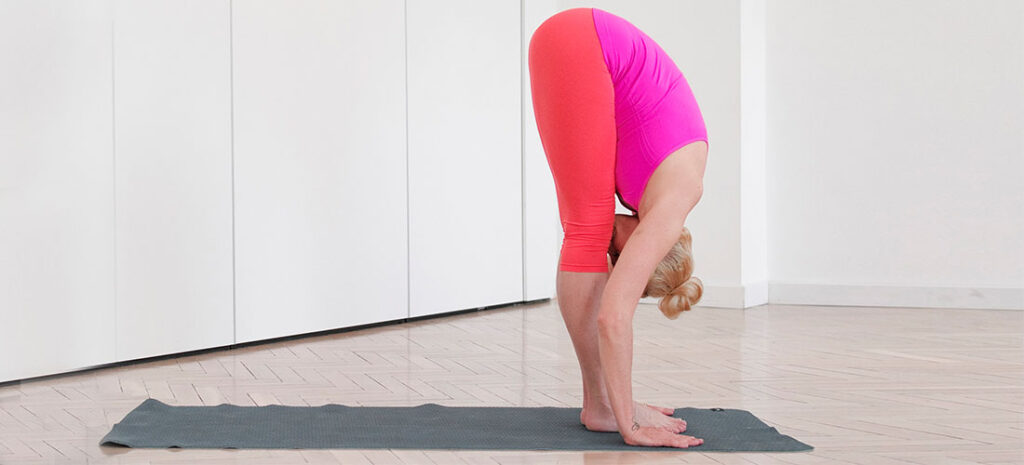
Beginning with your feet together in Mountain Pose, add a microbend to your knees. On an inhale, sweep your hands up overhead, and on an exhale, hing forward at the hips with a straight spine.
Keep your core engaged and avoid curving the back. Relax your head downward and feel a deep stretch in the back of your hamstrings.
Benefits: This classic toe-touching pose stretches your hamstrings and calves while challenging the core and releasing tension from the lower back.
Chakra Association: Root chakra (Muladhara), associated with the Earth element
Variations: Depending on your flexibility, place your hands on your shins, on each side of your feet, or on a yoga block.
3- Downward Facing Dog Pose (Adho Mukha Svanasana)

From a forward bend pose, bend your knees as much as needed and place your palms flat on the yoga mat. Step or jump your feet backwards and push your heels toward the ground. Your body will look like an upside down “v”.
On an exhale, allow your head to relax down between your shoulders and engage your core to flatten your back. Push your tailbone up toward the sky. On each inhale, lengthen your spine. On the exhales, draw your heels closer to the floor and push your torso toward your thighs.
Benefits: Downward facing dog pose is a light inversion that improves circulation, opens up the chest, challenges the back muscles, and lengthens the hamstrings. It can help relieve stress and tension in the neck and back. This is also the most important “resting pose” during sun salutations.
Chakra Association: Muladhara (root chakra), associated with the Earth element
Variations: If your heels don’t fully reach the floor, micro-bend your knees or utilize a yoga block. For ankle or wrist pain, try out a yoga wedge.
4- Warrior 2 Pose (Virabhadrasana II)
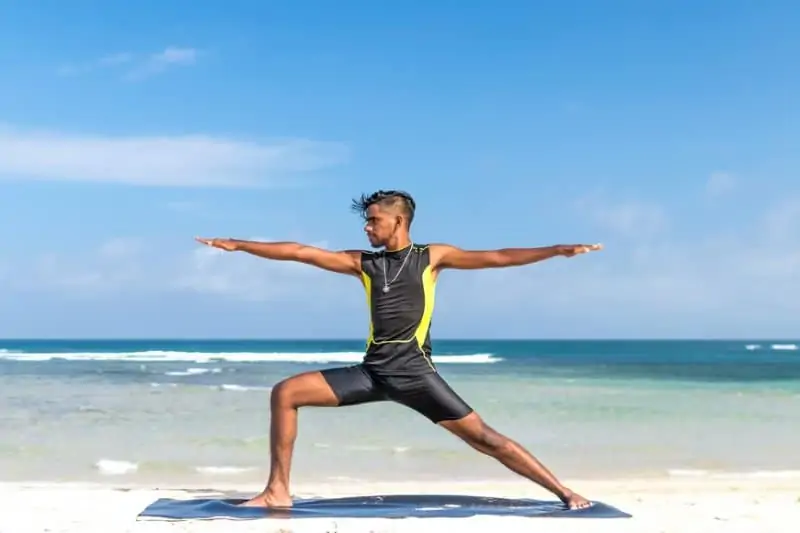
From downward dog, inhale to lift your right leg up toward the sky. On an exhale, bring it through to the front of the mat and place your right foot between your hands.
Angle the back left foot at a slight 45° angle with the wall, opening the middle arch forward and aligning the heel in an imaginary line with the front heel. Exhale and bend into the right knee until you have a right angle with your thigh parallel to the ground.
Bring your arms out to the side and point your fingers toward each end of the room, relaxing your shoulders. Gaze forward and breathe deeply for 5-10 breaths.
Exhale back into downward facing dog and repeat on the other side.
Benefits: Warrior II strengthens your core, quads, calves, and ankles. It stretches the back hamstring while opening your upper body and chest.
Chakra Association: Manipura (solar plexus chakra, linked to the fire element
Variations: If there is any discomfort in your back ankle, adjust the angle of your foot. If your shoulders lift, roll your shoulder blades back down and together, keeping them away from your ears.
5- Triangle Pose (Trikonasana)
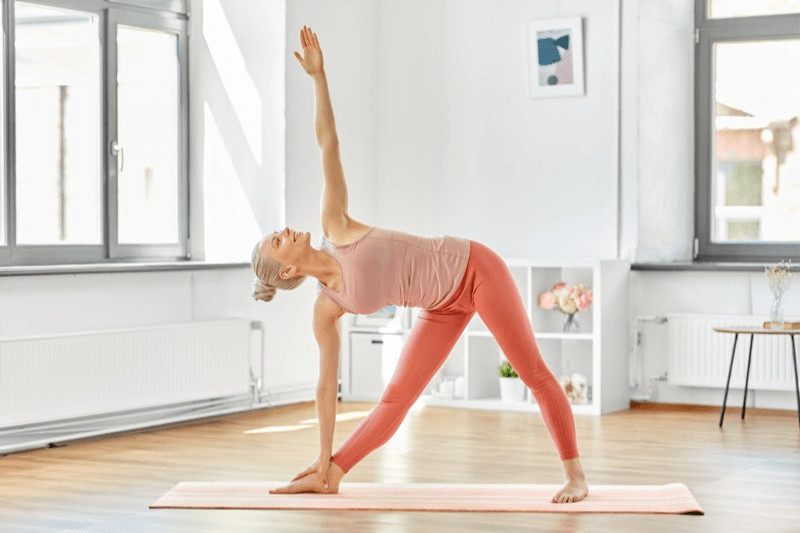
From Warrior pose, straighten the front leg and keep the front foot pointing forward. Your arms should still be out beside your body like a “t”.
Inhale to lengthen your spine and engage your core, then exhale as you reach your right arm forward and down, resting your hand on the inside of the right knee or shin.
The left arm reaches up toward the sky with your fingers spread. If it’s comfortable, turn your neck to look up. Your body should be in a flat plane as if between two walls.
Hold for 3 to 5 breath cycles and repeat on the other side.
Benefits: This hip-opening pose is great for your core, balance, and focus. It stretches the inner thighs and hamstrings while strengthening the legs.
Chakra Association: Manipura (solar plexus chakra, linked to the fire element
Variations: Place a block under the lower arm to help support alignment. Don’t allow your side body to collapse over the front leg.
6- Tree Pose (Vrikshasana)
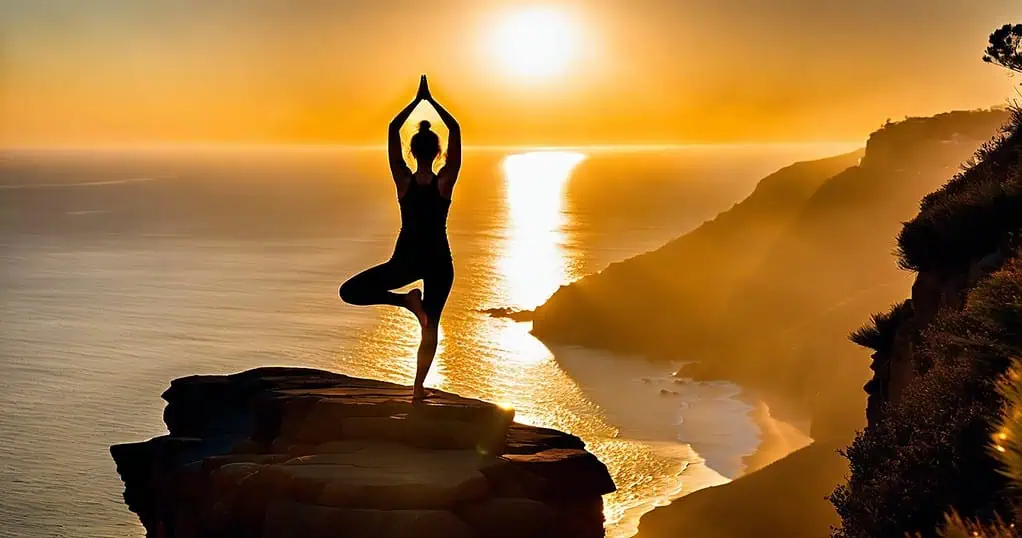
Return to Mountain pose and shift the weight into your right leg. Engage all the leg muscles as you press your foot into the ground and lift the left leg up in front of you.
Grab the inside of the left foot and place it just above your knee. If you have the flexibility, bring the top of the foot to rest on your thigh or on your hip bone. The left knee will externally rotate as you press into your leg.
Optionally, inhale and raise your arms above your head like tree branches. On each exhale, engage your muscles to keep your legs straight and maintain balance.
Hold for 5 to 8 breaths and repeat on the other side.
Benefits: Improve balance, open your hips, and strengthen your legs with tree pose.
Chakra Association: Muladhara (root chakra) and the Earth element
Variations: For those who lack flexibility or range of motion in their knee, tree pose can also be practiced with the foot on the lower calf or with a yoga strap.
7- Bow Pose (Dhanurasana)
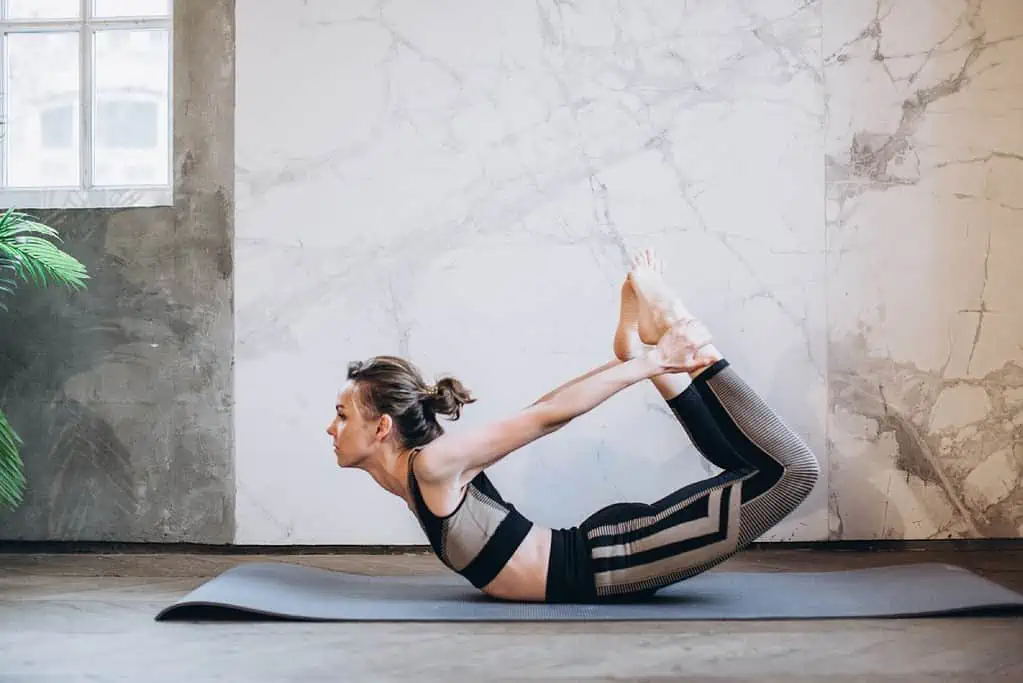
Lay on your mat flat on your stomach with the tops of your feet pressing into the floor. Bend your knees, reach back with both hands, and grab the outer edges of your feet and flex them.
On an inhale, let your ribcage and shoulders lift forward. With an exhale, begin kicking into your palms and lifting your glutes upward to arch to back. Keep lifting the head and heart as you gaze upward and push your thighs and stomach down in to the mat.
Hold for 3 to 5 breaths, aiming to rock forward onto your upper stomach if possible.
Benefits: Bow pose is incredibly energizing because it stimulates the adrenal glands, which help fight fatigue. Balancing on the small intestine is also great for stimulating the digestive system. It counteracts the negative effects of hunching over a desk all day and opens up the spine for more flexibility and improved posture.
Chakra Association: Manipura (solar plexus) and the fire element
Variations: If you cannot reach your ankles with your hands, use a yoga strap wrapped around the tops of the feet to extend your reach. Hold the strap overhead and lift with the glutes, opening your spine as much as is comfortable using the tension on the strap.
8- Locust Pose (Shalabasana)
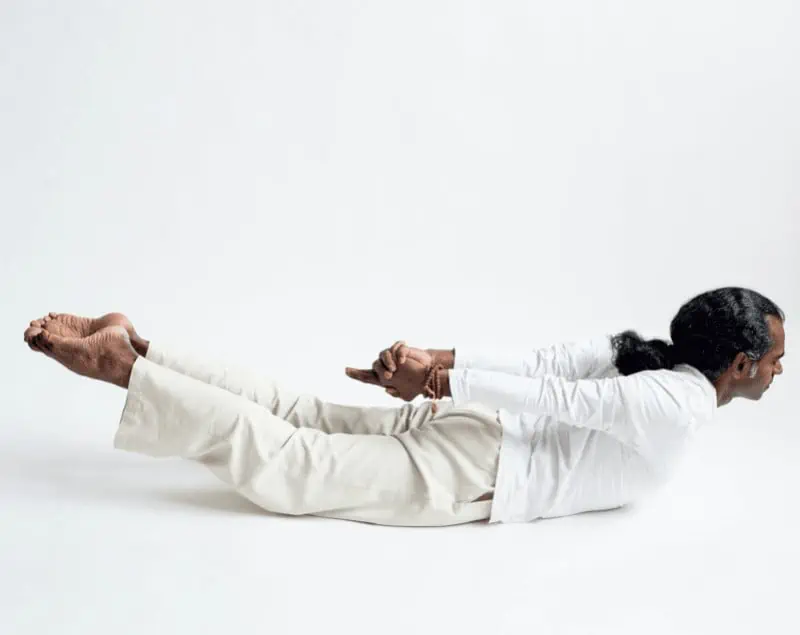
From bow pose, exhale and relax back to laying face-down on the mat. Straighten your legs and press the tops of your feet into the mat. Bring your hands on either side of the body just below the hip bones with palms facing down.
On an inhale, engage your core and back as you lift your chest forward and up. Keep the tops of your thighs and feet pressing downward. Hold for 3 to 5 breaths, opening your heart and chest to the sky as you engage all of your lower body and back muscles.
Benefits: Strengthen your legs, glutes, back, and abdominal muscles while you stimulate blood circulation and stretch the upper back.
Chakra Association: Svadhistana (Sacral chakra), linked to the water element
Variations: If you don’t want to rest the arms beneath the torso, rotate your shoulders backwards and clasp the hands together above your low back.
9- Cobra Pose (Bhujangasana)
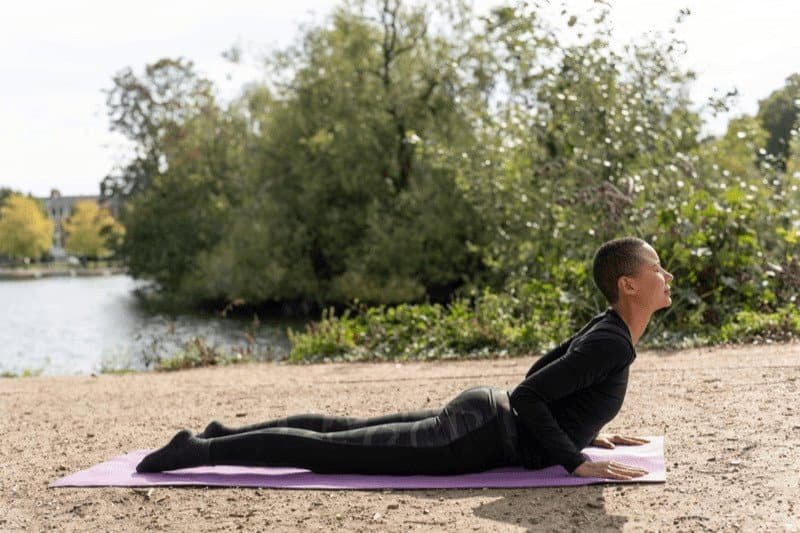
Returning to face-down position, straighten your legs and bring your feet together. Place your hands under your shoulders with fingers facing forward.
On an inhale, engage your core and lift the chest up as you gaze toward the sky. Elongate the spine and engage the legs so you don’t crunch into the low back. If you have the spinal flexibility, straighten your arms and press into the floor to fully open the front body.
Benefits: Cobra pose strengthens your back muscles and opens your heart. It feels incredible on your spine and upper torso. It also can improve respiratory and cardiovascular function.
Chakra Association: Anahata (heart chakra), correlated with the air element
Variations: For a more restorative stretch, keep the forearms and hands pressed into the ground.
10- Bridge Pose (Setu Bandhasana)
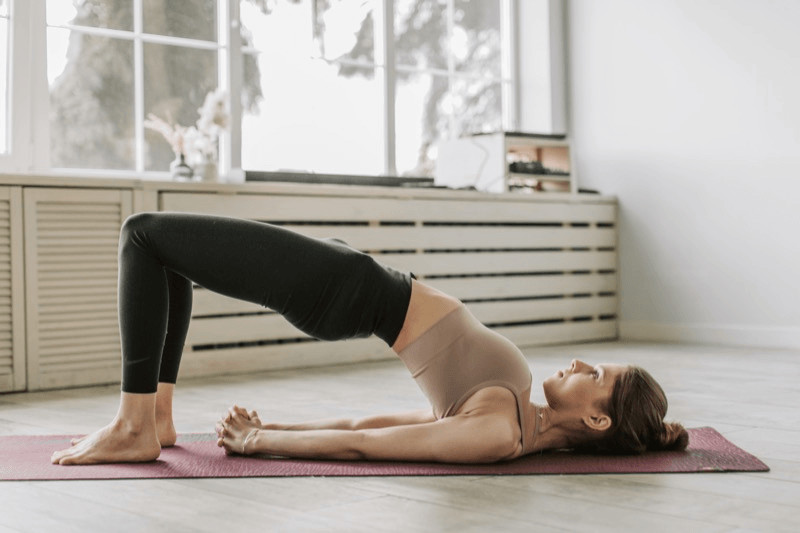
Begin laying in Savasana (corpse pose) flat on your back with your arms extended to your side, palms down. Bend your knees and press your feet into the mat at the point where your middle fingers can reach your heels.
On an inhale, draw your chin forward so your neck is elongated. On an exhale, engage the glutes and lift your hips up toward the ceiling.
Keep your legs engaged and aligned without allowing the knees to splay inwards or outward. The thighs should be straight in line with the body, ribcage lifted, and knees at approximately a right angle. Take 4 to 8 deep breaths, being sure not to overextend your spine. Then, gently lower to the ground.
Benefits: This backbend is great for spinal health and strengthening the legs. As you bring your chin to your chest, you also stimulate the thyroid gland, which regulates hormones.
Chakra Association: Manipura (solar plexus) and the fire element
Variations: You can clasp your hands together or keep your palms flat as you press into the ground. Clasping will create a bit more of a shoulder rotation and upper body stretch.
11- Fish Pose (Matsyasana)

To continue a back-bending sequence, return to Savasana (laying flat on your back) and bend your knees to place your feet on the floor. Inhale and lift your pelvis to slide your palms beneath your butt. You will be sitting on the tops of your hands.
Next, tuck your forearms close to your sides. On an inhale, press into the ground as you lift your head and torso off the floor. Exhale and release your head back onto the floor, arching your back as much as is comfortable to fully open your neck upwards.
The back of your head or the crown will rest on the floor, but there should not be much weight on your head. Avoid crunching into your neck by using your arms to press into the ground and arch your chest upward.
Benefits: Fish pose helps fight fatigue and stretch open the shoulders. It combats the impact of poor posture and helps reduce neck tension.
Chakra Association: Anahata (heart chakra) and Vishuddha (throat chakra)
Variations: As a beginner, it is safer to practice fish pose with the help of a yoga bolster or block to prevent crunching into your neck or spine.
12- Hero Pose (Veerasana)
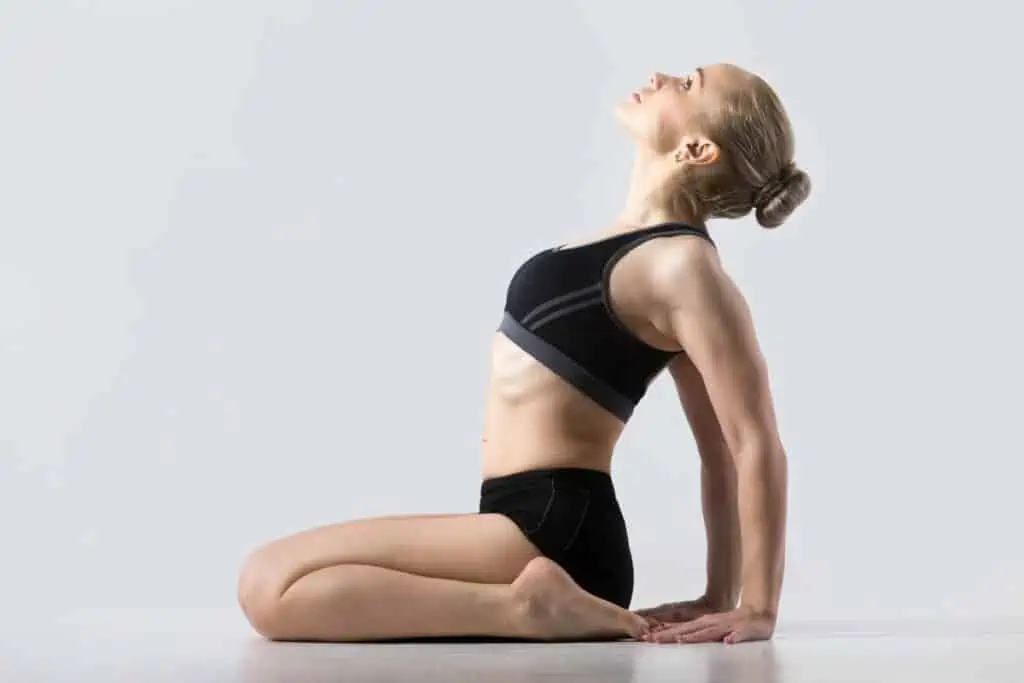
Begin with bent knees, kneeling on the mat. Place your palms on the floor to lift your butt up slightly. Bring your knees together and slide your feet wider than your hips with the tops of the feet resting on the mat. Adjust your toes to angle inward.
On an exhale, begin to sit back with your torso leaning slightly forward. If needed, adjust your calf muscles out of the way to shimmy your tailbone down to the floor between your thighs. Sit up straight and breathe.
Benefits: Hero pose is a seated meditation pose designed to deeply stretch the quads and improve blood circulation to the joints.
Chakra Association: Swadisthana (sacral chakra) and Muladhara (root chakra), associated with the water and Earth elements
Variations: If you struggle with knee pain, try placing a folded yoga blanket or bolster beneath your sit bones or wedged under your calves.
13- Pigeon Pose (Kapotasana)
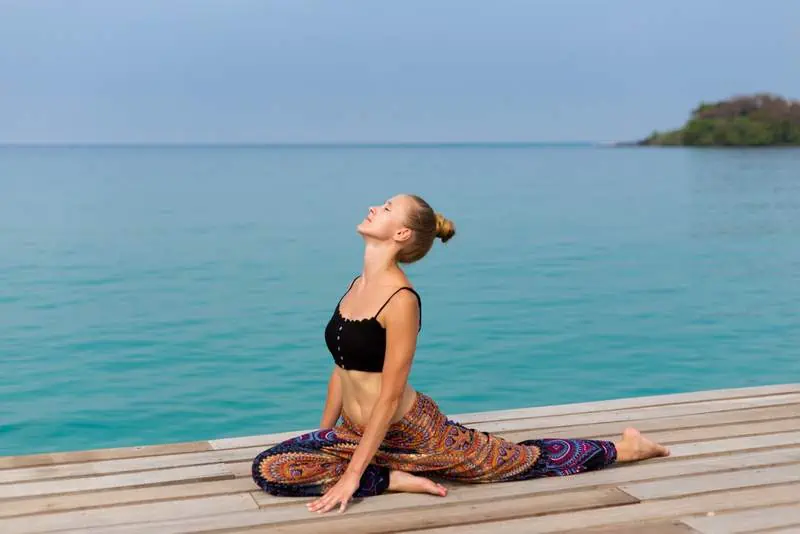
From a tabletop pose, inhale and bring your right knee forward. Externally rotate the knee and bring the right foot underneath the left hip bone.
On an exhale, slide your left leg back straight behind you. Adjust your hips to ensure they are aligned facing forward. Hold while upright, then on an exhale, slowly lower your upper arms to the ground. If you want a deeper stretch, bring your torso forward and lay over your leg.
Hold for 3 to 5 breaths and repeat on the other side.
Benefits: This deep hip opener is incredibly beneficial for joint mobility and reducing low back pain.
Chakra Association: Muladhara (root chakra) and the Earth element
Variations: A yoga blanket or bolster beneath the hip can help reduce hip pain and reduce the intensity of the pose. Those with less flexibility may prefer to keep their torso
14- Spinal Twist Pose (Matsyendrasana)
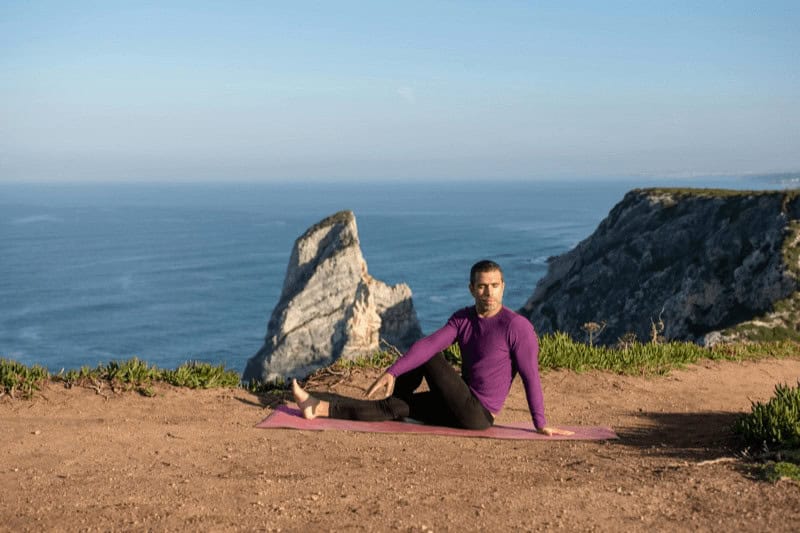
Start sitting with your legs stretched out in front of you. Inhale to lengthen and straighten your spine. Bend the left leg and place your left foot on the opposite side of your right knee.
On an inhale, engage your core and begin to slightly twist as you raise your right arm to the sky. Bring the right elbow to the outside of the left knee and exhale as look over your left shoulder.
Hold for 3 to 5 breaths, lengthening your spine on the inhales and deepening the twist on the exhales.
Benefits: This twist improves digestion as well as vertebrate mobility and posture. It helps relieve back pain and stretch the outer hips.
Chakra Association: Swadisthana (Sacral chakra) and the water element
Variations: You can also practice a similar pose while laying down and twisting one knee over your body.
15- Back Stretching Pose / Seated Forward Fold (Paschimottanasana)
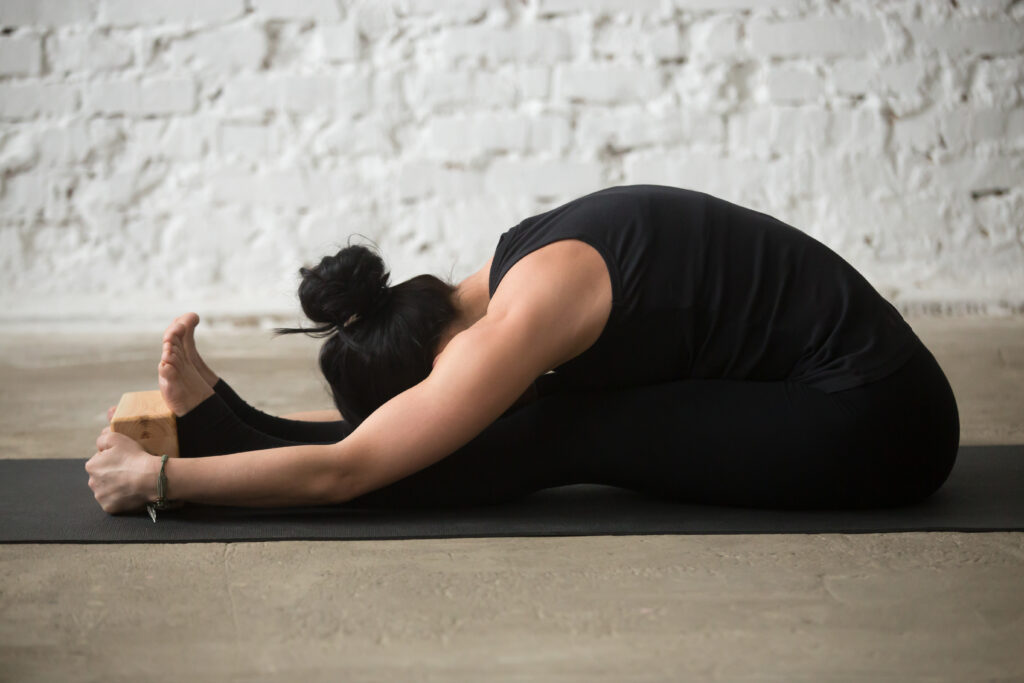
From a seated position, stretch your legs straight out in front of you. Micro-bend your knees. Inhale your arms up and then exhale as you fold forward and reach for your toes. Slowly scoot your tailbone backwards to straighten your legs as much as possible. Avoid hunching your spine over in a curved position.
Benefits: Forward bend pose is an excellent hamstring stretch.
Chakra Association: Manipura (solar plexus) and the fire element
Variations: If you can’t reach your toes, try utilizing a strap looped under the bottom of your feet.
Transitioning from Standing to Seated Positions
When you flow through a yoga sequence, shifting from standing to seated poses plays a role. It’s akin to a dance. Beginning in a standing position and feeling your body elongated and strong, you then seamlessly lower yourself to the floor in preparation for a stretch.
To start, stand tall. Ground your feet on the mat. Inhale deeply. With each exhale, envision transitioning into a posture. Perhaps you begin by bending, allowing your hands to touch the floor. Subsequently, you lower your knees. Settle into a seated position—all in one motion.
This shift isn’t about movement; it involves syncing your breath with your actions. Inhale while rising to stand; exhale as you fold forward and sit down. This synchronization encourages harmony between body and mind, transforming your practice into a moving meditation.
It’s essential to proceed at your own pace without haste. Embrace each transition mindfully. This shift presents an opportunity to slow down and fully engage in the moment—a defining aspect of hatha yoga essence. You’re not merely performing poses; rather, you’re cultivating a seamless progression embodying rhythm that guides you through your practice.
Incorporating Hatha Yoga into Your Daily Routine
One aspect often neglected in conversations about hatha yoga is the integration of hatha yoga sequences into tasks. It’s not about converting your workplace into a yoga studio. Rather, infuse the principles and poses of Hatha yoga into your activities.
Take, for example, the Mountain Pose (Tadasana). It’s more than a pose on the yoga mat – it’s a posture you can adopt while waiting in line or doing household chores. This pose teaches us to stand tall, rooted, and centered.
Similarly, there’s the Seated Forward Fold (Paschimottanasana). You can modify this pose while seated at your desk to help elongate your spine and alleviate tension after prolonged periods of sitting.
The breathing exercises or pranayama techniques from hatha yoga can be performed anywhere. They are particularly useful for managing stress during commutes or calming your mind before meetings.
Integrating yoga into your life doesn’t necessitate a mat or special attire. It’s about being present and infusing the essence of yoga into each moment. This holistic approach has the potential to enhance not only your well-being but also your mental health.
This practical integration of hatha yoga into routines seems to be overlooked in articles.
This fresh perspective could help our post get noticed. It demonstrates to readers how they can incorporate the advantages of hatha yoga into their lives, turning it into more than a workout routine.
Pop quiz! 🧘🤔
Hatha Yoga is only about physical postures.
The word Hatha in Sanskrit means effort or force.
Hatha Yoga does not incorporate breathing techniques like pranayama.
Hatha Yoga FAQs
What is hatha yoga good for?
Practicing hatha yoga can radically improve your flexibility, strength, muscular tone, joint mobility, and mind-body connection. It encompasses the classic yoga principles of asana, pranayama, and meditation. Hatha yoga holds poses for longer to encourage more balance and strength.
How many poses are there in a hatha class?
Unlike Bikram or Ashtanga, hatha yoga classes don’t necessarily have a set amount of poses. There are 15 primary hatha yoga poses, but dozens of other asanas and variations may be incorporated into a class depending on the yoga teacher.


